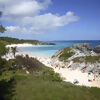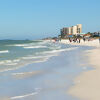15 Nights | Europe
About Rotterdam, Netherlands
You will visit the following 7 places:

Bermuda
Bermuda is a British Overseas Territory in the North Atlantic Ocean, located off the east coast of North America. It is one of the last remains of the once vast British colonial empire in North America. It consists of about 138 islands and islets, with all the major islands aligned on a hook-shaped, but roughly east-west, axis and connected together by road bridges. Despite this complexity, Bermudians usually refer to Bermuda as "the island". Bermuda's pink sand beaches and clear, cerulean blue ocean waters are popular with tourists. Many of Bermuda's hotels are located along the south shore of the island. In addition to its beaches, there are a number of sightseeing attractions. Historic St George's is a designated World Heritage Site. It's most famous visitor attraction is the Royal Naval Dockyard, which includes the Bermuda Maritime Museum. Other attractions include the Bermuda Aquarium, Museum and Zoo, Bermuda Underwater Exploration Institute, the Botanical Gardens and Masterworks Museum of Bermuda Art, lighthouses, and the Crystal Caves with stalactites and underground saltwater pools.

Rotterdam
Rotterdam is the second-largest city in the Netherlands and the largest port in Europe. Starting as a dam on the Rotte river, Rotterdam has grown into a major international commercial centre. Its strategic location at the Rhine-Meuse-Scheldt delta on the North Sea and at the heart of a massive rail, road, air and inland waterway distribution system extending throughout Europe means that Rotterdam can rightly be called the gateway to Europe. Located in the Province of South Holland, Rotterdam is in the west of the Netherlands and at the south of the Randstad. The population of the city proper was 603,425 in March 2010. The population of the greater Rotterdam area, called "Rotterdam-Rijnmond" or just "Rijnmond", is around 1.3 million people. Rotterdam is one of Europe's most vibrant and multicultural cities.

Tampa
Tampa is a Gulf Coast Bay city in the U.S. state of Florida. It serves as the county seat for Hillsborough County. Tampa is located on the west coast of Florida. The population of Tampa in 2000 was 303,447. According to the 2009 estimates, the city's population had grown to 343,890, making it the 54th largest city in the United States. The current location of Tampa was once inhabited by various indigenous cultures, most recently the Tocobaga. It was spotted by Spanish explorers in the early 16th century, but there were no permanent American or European settlements in the area until 1824, when the US Army established a frontier outpost called Fort Brooke at the site of today's Tampa Convention Center. The village of Tampa began as a small group of pioneers who settled near the fort for protection from the Seminole population in the area.

Ponta Delgada
Ponta Delgada is the largest municipality and administrative capital of the Autonomous Region of the Azores in Portugal. It is located on São Miguel Island, the largest and most populous in the archipelago. Cruise ships on repositioning voyages between North America and Europe often call there. Cruise-ship visitors to Ponta Delgada will often drive out into the countryside for visits to small villages and natural volcanic wonders. There's usually time afterward for a relaxed amble through the lovely port city, noted for its squares paved with black and white tiles, fabulous churches, and public buildings with their white-painted facades and brown-black volcanic stone trim. Given its dimension and the diversity of facilities and services it offers, Ponta Delgada is also the place for experiencing, a true gateway to the active discovery of the Azores Archipelago, with many things to do.

Zeebrugge

Brest

Cherbourg
Cherbourg-Octeville is a city and former commune situated at the northern end of the Cotentin peninsula in the northwestern French department of Manche. Due to its union, it is the most populated city in its department with 37,121 inhabitants making it the first city of the department before the Saint-Lô prefecture and the second in the region after Caen. Cherbourg-en-Cotentin is protected by Cherbourg Harbour, between La Hague and Val de Saire, and the city has been a strategic position over the centuries, disputed between the English and French. Cited as one of the "keys to the kingdom" by Vauban, it became, by colossal maritime development work, a first-rate military port under the leadership of Louis XVI and Napoleon, and holds an arsenal of the French Navy. A stopping point for prestigious transatlantic liners in the first half of the 20th century, Cherbourg was the primary goal of US troops during the invasion of Normandy in 1944. Along with its use as a military, fishing and yachting port, it is also a cross-Channel ferry port, with routes to the English ports of Poole and Portsmouth, the Irish port of Rosslare Harbour and St Helier on Jersey. Limited by its geographical isolation from being a great commercial port, it is nonetheless an important shipbuilding centre, and a working-class city with a rural hinterland.










